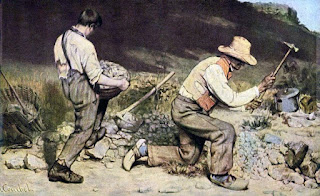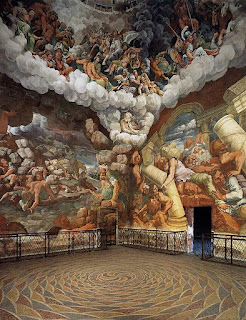Romantic Era - Impressionism & Realism
The Romantic era began approximately in 1770 but its peak period was from 1800 to 1850. This era was all about using their imagination in different forms of art in order to show what’s going on in their life or in the world at the time. So many different art forms are used to express what was going on in the Romantic era, the two styles that I chose is realism and impressionism.
What is Realism?
Realism is an artistic movement that began around the 1840s. This art style focuses on accurately creating art that is realistic and truthful. Artists that use realism in their work, their subject is typically about the lower/working class and the struggles that they encounter in order to show a truthful life.
What is Impressionism?
Impressionism began in the 1860s, but took off in the 19th century. This type of art is distinguished by small thin brushstrokes and it’s purpose is to highlight light in the painting in order to depict emotion. A great example of a painting that uses impressionism is the famous, The Starry Night by Vincent van Gogh.
The Stonebreakers created by Gustave Courbet in 1849 is an oil canvas about two men breaking and removing stone in order to create a new road. Courbet created this painting to show tough labor that people have to do day-to-day in order to make a little bit of money to survive. The category of art this goes under is realism because it shows a real life scenario of two men working hard.
A couple art elements that stood out to me from this painting was the use of lighting, dimensions, and detail. At first glance of the painting you can see light is shining on the two men working hard and the background shows a dark shadow on the hill, due to the dark background it really highlights the two men and their action. Courbet does a fantastic job at fitting every little detail in there like the shape of the rocks to the leaves, to the body position and shading of the man. Every crease of where it would fold on their clothing is accurate and it makes you look like you’re looking at a photo rather than a painting. Other things that I noticed were just little characteristics like the torn clothes and not showing their faces shows that they are every average lower class worker at the time. For me I wouldn’t necessarily on this painting because it’s not really my style and it’s depressing knowing the meaning behind it, but I do appreciate and respect the art.
Plowing in the Nivernias is an oil painting created in 1849 by Rosa Bonhuer in Musée d’Orsay, Paris. This piece portrays two herds of oxen plowing the land and two people guiding them. Bonhuer’s purpose of this painting is to show an appreciation for the Laborers both people and animals and to show that if they weren’t plowing the land, crops wouldn’t be planted, and their source of food would be struggling.
This piece of art goes under the category of realism, both the men and the oxen, as well as the scenery look so lifelike! Bonhuer did a fantastic job at highlighting her main subject which is the oxen, you can tell just by how they’re glowing due to the lighting and choice of color she made them. The balance of how she uses her space is perfect, the background is simple and not too busy while the oxen and soil are very detailed and definitely draws your attention, it’s a perfect in between. You can tell that Bonhuer used a flat thick brush for the sky to show a clear day, but I would suggest that she probably used a smaller find tip brush for the details and the soil and the livestock. I actually would love to own this painting if I had the opportunity, I love animals and showing history of what they were used for back in the day gives an appreciation for the animal.
Rising Tide at Pourville is an oil painting created by Claude Monet in France of 1882. This is an impressionist painting inspired by Gustave Corbett’s “Marine”.
Throughout Monet’s painting career he was known to create landscapes of the coast with its main focus being color and lighting of the painting. His use of blues, greens, white, and brown in this painting complement the scenery nicely because it gives dimension for the waves, and the cliff where the house resides. You can tell by looking at the waves that Monet used thick strokes of paint to depict the choppy ocean. His use of light in this painting shows that it’s a nice breezy summer day because of how he highlights the sky and the ocean. I would most definitely own this painting, it’s a nice landscape that I could see hanging at a cabin down in Homer, Alaska or the coast somewhere.
The Bridge at Villeneuve-la-Garenne is an oil painting created by Alfred Sisley in 1872. Sisley’s paintings were known to have state-of-the-art bridges, this bridge in particular was created in 1844 it is a cast iron bridge that connected the village of Villeneuve-la-Garenne.
I would suggest that Sisley used a thicker brush on the sky and water, and followed it with a thin brush to add detail in the water reflection as well as the clouds in the sky. My favorite part of this piece is the green little tent by the house I feel like Sisley did that on purpose so that you would go straight to the center of the painting and then gaze out word at the houses, the hill, the bridge and etc. Which means he does an excellent job with his use of lighting by highlighting the city and shadowing the bridge. Overall, I probably would not own this painting to my surprise, it’s not necessarily my style, but by all means it is admirable!
“Romanticism Movement Overview.” The Art Story, https://www.theartstory.org/movement/romanticism/#:~:text=Romanticism%20celebrated%20the%20individual%20imagination,into%20the%2020th%20century.
Artincontext. “‘The Stone Breakers’ Gustave Courbet - A History and Analysis.” Artincontext.org, 12 May 2022, https://artincontext.org/the-stone-breakers-gustave-courbet/.
Scott, Dan, et al. “A Closer Look at Ploughing in the Nivernais by Rosa Bonheur.” Draw Paint Academy, 8 Feb. 2023, https://drawpaintacademy.com/ploughing-in-the-nivernais/.
“Rising Tide at Pourville (Marée Montante à Pourville).” Brooklyn Museum, https://www.brooklynmuseum.org/opencollection/objects/52641.
British, Alfred Sisley. “Alfred Sisley: The Bridge at Villeneuve-La-Garenne.” The Metropolitan Museum of Art, 1 Jan. 1872, https://www.metmuseum.org/art/collection/search/437680.






Comments
Post a Comment